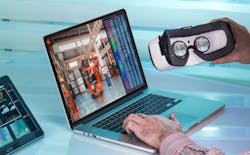The Future of Trade Shows for Manufacturing Technology
Traditional trade shows are a significant aspect of manufacturing technology. Operators and managers, executives and engineers, and other manufacturing tech professionals fill conference and exhibition centers to learn about and see new developments, and networking to make new connections in the industry. At the same time, the Internet affords increasing interconnectedness – and that has opened up a whole new world for networking.
In lieu of (or in addition to) the actual booths and face-to-face pitches, manufacturing tech professionals are moving in the virtual trade show space. Online marketing is a fixture of just about every organization and industry, B2C and B2B alike. This digital evolution allows them to transcend geographical borders promises tremendous growth potential.
Shift from traditional to digital
Online events and marketing materials allow for a more immersive and dynamic experience for potential customers and partners. These are some of the technologies that have reshaped the way trade shows serve their target audience:
- Augmented reality: AR allows presenters to overlay contextual information, like products superimposed on a warehouse through the lens of a smartphone or AR headset. This lets participants visualize clearly what it would be like to have your tech in their actual workplace.
- Virtual reality: VR is a similar immersive experience that uses headsets to transport participants to new environments. Rather than layering over an environment, a 3D rendering lets participants see what it’s like to be in a workplace and interact with virtual components of a product.
- Live streaming and webinars: Real-time footage of events or live virtual events bring content to a potentially global audience. Attendees can participate from anywhere and engage with speakers with features like an interactive Q&A and polls.
These digital versions of trade shows redefine what it means for exhibitors to show their products and brand. Either as a supplement to in-person trade shows or in their stead, these technologies promote networking among people who normally would not meet in person, and to engage in ways they have never seen before.
Benefits of virtual engagement
Providing novel, immersive experiences for potential customers and partners is a great way to position your brand as a forward-thinking, customer-focused player in your industry. By blurring the lines between physical and virtual spaces, you can use various features to benefit your business. Some of the most pertinent perks of virtual marketing for manufacturing tech include:
- Adaptability: A virtual environment is easier to change on the fly than, say, trade show signage. You can adjust your marketing strategy as you go based on real-time engagement and feedback;
- An even playing field: Virtual events and content allow businesses of all shapes, sizes, and locations to stand out in the industry;
- Broader, faster reach: Online avenues allow you to transcend borders and reach a global audience. You can also use demographics to target your ideal consumers and partners, reaching them directly and quickly while they are in the market for your product;
- Cost-effectiveness: Digital marketing reduces the need for physical venues, travel costs, and traditional marketing materials, saving you money, time, and resources that can be allocated elsewhere;
- Enhanced data analytics: You can also dive deeper into analytics with data provided by digital platforms. This can inform your future marketing strategy, boosting conversions and your return on investment (ROI).
All of these benefits combine to make a marketing powerhouse. The future of your manufacturing tech events and marketing lies in your ability to harness digital tools and features to your advantage.
There are many approaches you may take to digital marketing for manufacturing technology. These are some strategies you may consider adopting:
- Blog posts: Search engine-optimized articles can show up when your target audience is looking to learn more about your product, industry, or a niche topic within that industry. Creating a content funnel with an internal linking structure can lead your readers to purchase products or sign up for events.
- Chatbots: Virtual assistants can be available to chat with website visitors 24/7, answering questions and offering information. You can integrate an event or email signup form and offer other ways to contact you.
- Educational ebooks and whitepapers: Educational digital content is an asset to your marketing strategy, allowing you to provide value to potential clients and partners.
- Email campaigns: Once users sign up for your email list, you can send out this digital content, as well as event calendars and reminders in place of physical invitations.
- Live-streamed events: If you’re already attending or hosting a trade show, you can set up a webcam or external camera and a laptop or mobile phone to stream the event live. This way, those who cannot make it can still attend, expanding your reach and boosting engagement.
- Social media marketing: A social media presence is essential, even in the B2B space. Use social platforms to boost your reach, publish content, post behind-the-scenes photos and videos, make announcements, and even serve as a live-streaming space for events;
- Virtual events and webinars: You can host and attend events that are completely online. This allows more people to attend and interact via polls and Q&A sessions. You can also set up AR and VR capabilities for a more immersive experience.
Digital spaces are always evolving, so staying up to date with advancements in this area will allow you to stand out and use cutting-edge innovations. Digital marketing and events help you stand out from the crowd, but they are not without hurdles and hiccups.
Challenges with virtual events
In-person trade shows can have challenges like adverse weather, power outages, and layout issues to name a few. Online events are not immune to challenges — but they may look a bit different. While most internet users are quite savvy, you still may run into issues where participants cannot figure out how to join a live stream or participate effectively. There is a learning curve as well as a financial barrier to entry, particularly with events that require AR or VR headsets or capabilities. Try to make it easy for everyone to attend with step-by-step instructions and options to join without AR and VR.
You also may run into tech issues during live events. Backup internet connections are crucial to remain online for your attendees. You can run into issues like internet outages caused by weather events, equipment failures, software issues, network provider failures, or large traffic volumes. Smaller events can prevent the latter, but you can upgrade your hardware or use third-party services that are equipped to handle large online audiences. Having an extra internet connection can ensure you stay online if power goes out or hackers make their way into your network.
Prolonged screen time may lead to attendee fatigue, so devise solutions to keep them engaged. Vary your event content, including videos, interactive polls, and demonstrations. Smaller event sizes also allow for more personalized networking opportunities, so consider creating virtual events with a cap on the number of attendees. This creates an air of exclusivity.
Tracking KPIs, maximizing ROI. Virtual events and marketing provide valuable data insights. Key performance indicators can inform your future strategy, enhancing attendee engagement and driving ROI. Some KPIs to consider tracking include event registrations, actual attendees, popular questions, poll results, and conversions.
With this information, you can tailor your next event to boost ROI. Consider providing discounted or tiered pricing models to event attendees to incentivize them to attend and make purchases. To open up your audience even further, offer live captions and translations.
You can also boost visibility and excitement by bringing in influential speakers or partnering with other industry leaders.
Industry networking, nurturing connections. Your online marketing should attract your ideal customer, and you should be prepared to engage with them effectively. Data gathered from online marketing and events will be crucial in targeting your audience and leading them through your sales funnel. You want to nurture the connections you make through online events with follow-up emails and messaging.
You can speak your clients’ language by honing in on feedback you receive during online events. Rather than cramming buzzwords into your messaging, personalize emails and content based on how your attendees talk. Networking dynamics are different online, but they provide more tangible evidence of interactions.
A virtual manufacturing tech booth can reshape the future of your business. By embracing digital marketing, you expand your reach and gather valuable insights that will lead you to connect, innovate, and drive progress like never before.
Ainsley Lawrence is a freelance writer and editor.
About the Author
Ainsley Lawrence
Ainsley Lawrence is a freelance writer and editor.


